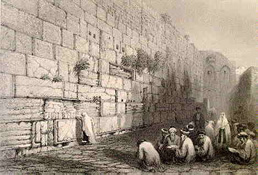 |
Jews’
place of wailing* |
In the days of her affliction and wandering
Jerusalem remembers all the treasures
that were hers in days of old...
Lamentations 1:7
Tisha B’Av, means literally “the ninth of Av”, a day set aside for mourning the tragedies that have befallen the Jewish people throughout their long history. It was established primarily to commemorate the destruction of the first and second Temples in Jerusalem, both of which were coincidentally destroyed on the ninth of Av—the first by the Babylonians in 586 BCE, the second by the Romans in 70 CE. However it is also an occasion to remember other incidents, such as the expulsion of the Jews from Spain in 1492 CE.
The restrictions observed during this day are similar to those for Yom Kippur. Believers are expected to refrain from eating, drinking, washing, shaving or wearing cosmetics and they are expected to spend the day studying the Torah. Work is also restricted, although people who are ill are not required to fast. Many traditional mourning practices are also observed, such as refraining from idle conversation and unnecessary frivolity. In synogogues the ark holding the Torah scrolls is draped in black and readings take place from the book of Lamentations.